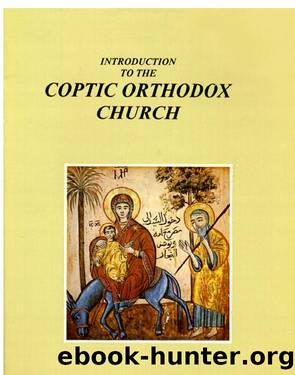INTRODUCTION TO THE COPTIC ORTHODOX CHURCH by FR. TADROS Y. MALATY

Author:FR. TADROS Y. MALATY
Language: eng
Format: epub
Tags: INTRODUCTION TO THE COPTIC ORTHODOX CHURCH, INTRODUCTION TO THE COPTIC ORTHODOX CHURCH
Published: 0101-01-01T00:00:00+00:00
COPTIC PERSONALITIES DURING
THE OTTOMAN ERA
1. POPE MATTHEOS (MATTHEW) IV
He was called Guirguis. He descended from a pious and rich family. He was educated in the Kettab (a school attached to the church), and became a monk in the Scetis wilderness.
After six years he saw in a dream that his parents were sad because they did not know his whereabouts. After consulting the fathers, he went to visit his parents. They were glad to see him and wished to see him married, but he fled back to the monastery. His parents realized his wish in the monastic life and were comforted.
He was much liked by the monks, who chose him as their spiritual father and he was ordained priest. He was faithful and vigilant as being their shepherd. He was elected as pope of Alexandria on the 3rd of Hator 1376 (1660 A.D.), and became a great support for his people during the tribulations which the rulers inflicted on them.
Once a Copt did a favor to the ruler, and started collecting taxes from the Copts in additions to the required tax. The Pope admonished him to stop that cruelty, and when he disobeyed he was excommunicated and died in bad circumstances shortly after.
A lady went to the Pope complaining of her husband who married another woman. The Pope called the man and the 183
second wife and exhorted them, but the woman replied that she had conceived and could not separate from him. The Pope answered earnestly: "The Lord Christ discerns the truth from the false," and then he kept silent. As soon as the woman returned, the fetus was aborted and people were filled with God's fear.
Some of the rebellions went to St. Mercerius' church aiming at destroying it. They requested the "Dewan" [the government office] to appoint an "Agha" [a responsible man]
to facilitate and assist them in their vicious play. The pope had no resource other than the Heavenly Father, and he spent the night in vigilance and prayers. The rebellions stayed overnight beside the church planning to commence their work at dawn. However, the wall of the adjacent house fell on them and they all died. Then no one else ventured to destroy the church. One of the known writings of Pope Mattheos IV is an essay, with an upright orthodox mind, about the "Divine presence in the Eucharist."
When He felt that the end of his sojourn on the earth was near he went to pray near the tomb of the popes in the church of Abi-Seffin (St. Mercerius), and was heard saying:
"Open and allow me to dwell among brothers."
During his era, Vansleb1, a Dominican monk, visited Egypt and wrote "History of the Coptic Church," in which he recorded his observations about the Coptic ecclesiastical life.
He carried with him 300 manuscripts.
Also during his era some of the Venicians stole the icon of the Archangel Michael from St. Mark's church in Alexandria and took it to the ship on their way to Europe, but the ship 184
could not sail until they returned the icon to its place.
Download
This site does not store any files on its server. We only index and link to content provided by other sites. Please contact the content providers to delete copyright contents if any and email us, we'll remove relevant links or contents immediately.
| Amish | Catholicism |
| Christian Science | Jehovah's Witness |
| Mennonite | Messianic Judaism |
| Mormonism | Orthodoxy |
| Protestantism |
Under the Banner of Heaven: A Story of Violent Faith by Jon Krakauer(1721)
The Early Centuries - Byzantium 01 by John Julius Norwich(1679)
The Amish by Steven M. Nolt(1512)
Taken by J. C. Owens(1508)
In Spirit and Truth (In Spiritu Et Veritate Series) by Reed Zoe(1499)
Play It as It Lays by Joan Didion(1449)
The Apogee - Byzantium 02 by John Julius Norwich(1390)
The Last Man in Russia by Oliver Bullough(1342)
A History of the Amish by Steven M. Nolt(1235)
David Sedaris Diaries by David Sedaris(1196)
Leaving the Witness by Amber Scorah(1182)
Tears of the Silenced: A True Crime and an American Tragedy; Severe Child Abuse and Leaving the Amish by Misty Griffin(1158)
Fallen by unknow(1156)
The Dance of Change by unknow(1134)
The Angel of Forest Hill by Cindy Woodsmall(1103)
The Best of Amish Cooking by Phyllis Pellman Good(1092)
The Ariana Trilogy by Rachel Ann Nunes(1084)
Deep Blue by unknow(1081)
Escape by Carolyn Jessop & Laura Palmer(1068)
